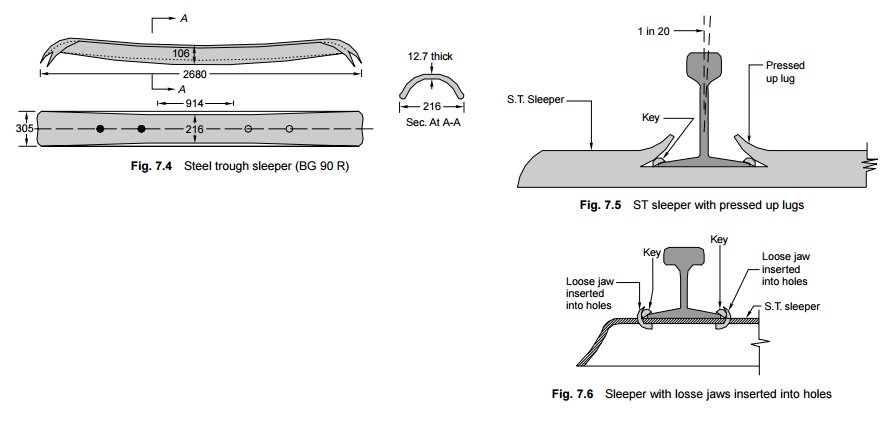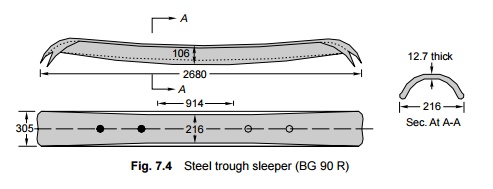Chapter: Civil : Railway Airport Harbour Engineering : Railway Engineering : Sleepers
Steel Channel Sleepers

Steel Channel Sleepers
In view of the great shortage of
wooden sleepers, steel channel sleepers have been developed by Indian Railways
particularly for use on girder bridges. Steel channel sleepers can be used for
welded plates, riveted plates, as well as open web girders.
Composite sleepers have been
developed indigenously in India as a replacement for wooden sleepers. These are
made from waste products such as used rubber tyres, and the manufacturers claim
a lifespan of about 40 years for these sleepers. The Patel Group of Industries
is one such firm that has developed these composite sleepers.
Composite sleepers are similar to
wooden sleepers and use similar fittings. These sleepers are under trial and
the results so far have been quite encouraging.
Steel Trough Sleeper
About 27% of the track on Indian Railways is laid on steel
sleepers (Fig. 7.4). The increasing shortage of timber in the country and other
economical factors are mainly responsible for the use of steel sleepers in
India. Steel sleepers have the following main advantages/disadvantages over
wooden sleepers.

Advantages
(a) Long life
(b) Easy to
maintain gauge and less maintenance problems
(c) Good
lateral rigidity
(d) Less
damage during handling and transport
(e) Simple
manufacturing process
(f) Very good
scrap value
(g) Free from
decay and attack by vermin
(h) Not
susceptible to fire hazards
Disadvantages
(a) Liable to
corrode
(b) Unsuitable
for track-circuited areas
(c) Liable to
become centre-bound because of slopes at the two ends
(d) Develops
cracks on rail seats during service
(e) Design is
rail specific
1 Design Features
The steel trough sleeper
essentially consists of a rolled steel plate of about 2 mm thickness pressed
into a suitable trough shape and the rail seat canted to 1 in 20. The ends of
the rolled section are flattened out in the shape of a spade to retain the
ballast. Two alternative types of sleepers have been designed for each rail
section as per the following details.
1. In one type, the lugs or jaws are
pressed out of the plate itself to accommodate the foot of the rail and the key
(Fig. 7.5). There are several maintenance problems with these pressed up lugs,
as they give way due to the movement of the keys as well as due to the
vibrations and impact of the moving loads.
2. In order to obviate this defect,
another sleeper design has been adopted. In this design, two holes are punched
into either side of the plate to accommodate specially designed 'loose jaws'
(Fig. 7.6). The rails are held with the help of two standard keys driven either
into the pressed up lugs or into the loose jaws.

The adjustment of the gauge to
the extent of ± 3 mm is done by properly driving in the keys. In the
double-line section, the keys are driven in the direction of the traffic. The
approximate weight of a standard BG trough sleeper is 81 kg and that of an MG
sleeper is 35 kg. The steel trough (ST) sleeper has an average life of about 50
years. It is an acceptable type of sleeper for use with long welded rails
because of its lateral stability and its adaptability for use along with
elastic fastenings.
2 Classification
All steel sleepers conforming to
Indian Railways specifications T-9 are classified as first quality sleepers.
The sleepers not accepted as first quality but free from the following defects
are termed second quality steel trough sleepers.
(a) Inward
tilt at rail seat beyond the limits of 1 in 15 to 1 in 25
(b) Sleepers
with a twist
(c) Heavy
scale fitting or deep grooves or cuts
(d) Deep
guide marks at heads, blisters, etc.
All first quality sleepers are
normally marked by a green dot. Sleepers that have been rejected as first
quality sleepers on account of pipes, seams, and laps but are free from the
defects indicated above are marked with a cross (×) in yellow paint at the
centre. All other second quality steel trough sleepers are marked distinctly
with a 15-cm-wide strip of yellow paint at one end. Sleepers that are unfit as
second quality are given a distinct red paint mark to avoid mixing them up with
first and second quality sleepers during loading.
3 Maintenance Problems
It has been noticed that the keys
used to fix rails on steel sleepers tend to become loose due to the bending of
the pressed up lugs or due to wear at the rail seat. The holes also get
elongated during service. Special types of shims and liners are provided in
these cases to hold the gauge well. Mota Singh Liner is a very effective type
of liner used for holding the correct gauge for oblong holes with loose jaws.
Another maintenance problem with steel trough sleepers is that these tend to
become centre-bound if due care is not taken while packing. The ballast is
normally removed from the centre of the sleepers after packing so as to ensure
that centre binding of the sleepers does not take place. Sometimes the
alignment of steel sleeper tracks also gets affected by the overdriving of the
keys.
Related Topics